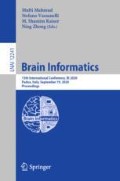Abstract
Classification of sleep-wake is necessary for the diagnosis and treatment of sleep disorders, and EEG is normally used to assess sleep quality. Manual scoring is time-consuming and requires a sleep expert. Therefore, automatic sleep classification is essential. To accomplish this, features are extracted from the time domain, frequency domain, wavelet domain, and also from non-linear dynamics. In this study, a novel Jaya Optimization based hyper-Parameter and feature Selection (JOPS) algorithm is proposed to select optimal feature subset as well as hyper-parameters of the classifier such as KNN and SVM, simultaneously. JOPS is self-adaptive that automatically adapts to the population size. The proposed JPOS yielded the accuracy of 94.99% and 94.85% using KNN and SVM, respectively. JPOS algorithm is compared with genetic algorithm and differential evaluation-based feature selection algorithm. Finally, a decision support system is created to graphically visualize the sleep-wake state which will be beneficial to clinical staffs. Furthermore, the proposed JOPS can not only be used in sleep-wake classification but could be applied in other classification problems.
A. A.-M. Bulbul and M. Abdul Awal—Equal Contributions.
Access this chapter
Tax calculation will be finalised at checkout
Purchases are for personal use only
Notes
- 1.
In 10-fold cross validation, one-fold is used for testing and nine other folds are used for training and repeated ten times so that each fold i.e. whole dataset is tested.
References
Littman, A.J., et al.: Sleep, ghrelin, leptin and changes in body weight during a 1-year moderate-intensity physical activity intervention. Int. J. Obes. 31, 466–475 (2007)
Park, H.-J., Oh, J.-S., Jeong, D.-U., Park, K.-S.: Automated sleep stage scoring using hybrid rule- and case-based reasoning. Comput. Biomed. Res. 33, 330–349 (2000)
Yeh, Z.-T., Chiang, R.P.-Y., Kang, S.-C., Chiang, C.-H.: Development of the insomnia screening scale based on ICSD-II. Int. J. Psychiatry Clin. Pract. 16, 259–267 (2012)
Leger, D., Pandi-Perumal, S., Healthcare, I.: Review of sleep disorders: their impact on public health. Public Health 30, 92161 (2007)
Ram, S., Seirawan, H., Kumar, S.K.S., Clark, G.T.: Prevalence and impact of sleep disorders and sleep habits in the United States. Sleep Breath. 14, 63–70 (2010). https://doi.org/10.1007/s11325-009-0281-3
Vaughn, B.V., Giallanza, P.: Technical review of polysomnography. Chest 134, 1310–1319 (2008)
Hassan, A.R., Bhuiyan, M.I.H.: Automatic sleep stage classification. In: 2nd International Conference on Electrical Information and Communication Technologies (EICT), pp. 211–216 (2015)
Hassan, A.R., Bhuiyan, M.I.H.: A decision support system for automatic sleep staging from EEG signals using tunable Q-factor wavelet transform and spectral features. J. Neurosci. Methods 271, 107–118 (2016)
Rodríguez-Sotelo, J.L., Osorio-Forero, A., Jiménez-Rodríguez, A., Cuesta-Frau, D., Cirugeda-Roldán, E., Peluffo, D.: Automatic sleep stages classification using EEG entropy features and unsupervised pattern analysis techniques. Entropy 16, 6573–6589 (2014)
Chen, K., Zhang, C., Ma, J., Wang, G., Zhang, J.: Sleep staging from single-channel EEG with multi-scale feature and contextual information. Sleep Breath. 23(4), 1159–1167 (2019). https://doi.org/10.1007/s11325-019-01789-4
Ghimatgar, H., Kazemi, K., Helfroush, M.S., Aarabi, A.: An automatic single-channel EEG-based sleep stage scoring method based on hidden Markov Model. J. Neurosci. Methods 324, 108320 (2019)
Tiwari, V., Jain, S.C.: An optimal feature selection method for histopathology tissue image classification using adaptive jaya algorithm. Evol. Intel. 1–14 (2019). https://doi.org/10.1007/s12065-019-00205-w
Hassan, A.R., Bhuiyan, M.I.H.: Automated identification of sleep states from EEG signals by means of ensemble empirical mode decomposition and random under sampling boosting. Comput. Methods Programs Biomed. 140, 201–210 (2017)
Rahman, M.A., Hossain, M.A., Kabir, M.R., Sani, M.H., Abdullah Al, M., Awal, M.A.: Optimization of sleep stage classification using single-channel EEG signals. In: 2019 4th International Conference on Electrical Information and Communication Technology (EICT), pp. 1–6 (2019)
Rao, R.: Jaya: a simple and new optimization algorithm for solving constrained and unconstrained optimization problems. Int. J. Ind. Eng. Comput. 7, 19–34 (2016)
Teo, J.: Exploring dynamic self-adaptive populations in differential evolution. Soft. Comput. 10, 673–686 (2006). https://doi.org/10.1007/s00500-005-0537-1
Rao, R.V., Rai, D.P., Balic, J.: A multi-objective algorithm for optimization of modern machining processes. Eng. Appl. Artif. Intell. 61, 103–125 (2017)
Venkata Rao, R., Saroj, A.: A self-adaptive multi-population based Jaya algorithm for engineering optimization. Swarm Evol. Comput. 37, 1–26 (2017)
Khushaba, R.N., Al-Ani, A., Al-Jumaily, A.: Feature subset selection using differential evolution and a statistical repair mechanism. Expert Syst. Appl. 38, 11515–11526 (2011)
Siddiqi, U.F., Sait, S.M., Kaynak, O.: Genetic algorithm for the mutual information-based feature selection in univariate time series data. IEEE Access 8, 9597–9609 (2020)
Babatunde, O.H., Armstrong, L.: A genetic Algorithm-Based feature selection. Br. J. Math. Comput. Sci. 5, 889–905 (2014)
Acknowledgements
This work is a part of the work supported by Khulna University Research Cell (KURC).
Author information
Authors and Affiliations
Corresponding author
Editor information
Editors and Affiliations
Rights and permissions
Copyright information
© 2020 Springer Nature Switzerland AG
About this paper
Cite this paper
Bulbul, A.AM., Abdul Awal, M., Debjit, K. (2020). EEG Based Sleep-Wake Classification Using JOPS Algorithm. In: Mahmud, M., Vassanelli, S., Kaiser, M.S., Zhong, N. (eds) Brain Informatics. BI 2020. Lecture Notes in Computer Science(), vol 12241. Springer, Cham. https://doi.org/10.1007/978-3-030-59277-6_33
Download citation
DOI: https://doi.org/10.1007/978-3-030-59277-6_33
Published:
Publisher Name: Springer, Cham
Print ISBN: 978-3-030-59276-9
Online ISBN: 978-3-030-59277-6
eBook Packages: Computer ScienceComputer Science (R0)

